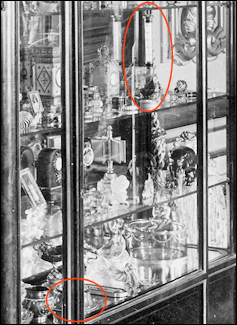
(A.) Xenia Alexandrovna Vitrine in the 1902
von Dervis Exhibition with (#420 top red oval)
Fabergé Standing Thermometer, and
(#447 bottom red oval)
Fabergé Circular Wall Barometer;
(Stockholm’s Auktionsverk,
June 16, 2015, Lot 6524)
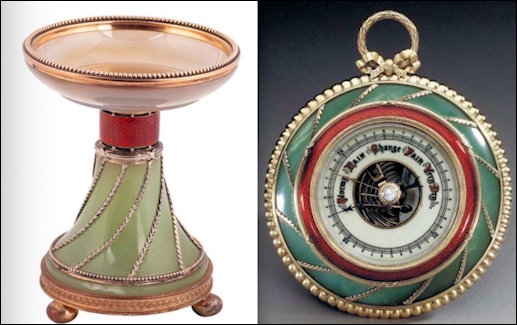
(B.) #420 Fabergé Standing Thermometer, (Baltic Auction, June 9, 2020, Lot 16)
#447 Fabergé Circular Wall Barometer, (Christie’s New York, October 25, 2000, Lot 536)
Two similar Fabergé clocks on wooden stands (C. and E.) situated on the top shelf of Xenia’s vitrine in the von Dervis Exhibition survived the Revolution, but changed over time.
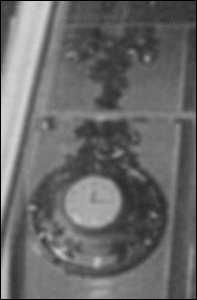
(C.) Fabergé Clock on Wooden
Stand (#379) Xenia Alexandrovna
Vitrine in the 1902 von Dervis
Exhibition (Stockholm’s Auktionsverk,
June 16, 2015, Lot 6524)
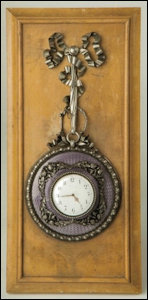
(D.) Fabergé Clock on Wooden
Stand…showing losses and
alterations to the silver
ornaments… (#379) (Ivanov,
Alexander, The Art of Fabergé
Exhibition at the Kostroma
State Historical and Artistic
Museum Reserve, 2010, p. 26.)
In Russian.

(E.) Fabergé Clock on Wooden
Stand (#393) Xenia
Alexandrovna Vitrine in
the 1902 von Dervis Exhibition
(Stockholm’s Auktionsverk,
June 16, 2015, Lot 6524)
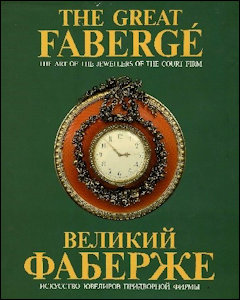
(F.) Fabergé Clock on Wooden Stand…having
lost its wood stand…(#393) “Received
from Hotel ‘Astoria’ 1985.” (The Great Fabergé:
The Art of the Jewellers of the Court Firm,
1990, Cover and Written Description
on p. 120, Item 8)
Its counterpart at the 1902 Exhibition, the clock (E.) graces the cover (F.) of the 1990 Elagin Palace exhibition catalog even though it has lost its wooden stand, and is not detailed in the catalog’s written descriptions. Our research journey took many turns, but now the clock has a chronology:
-
January 4, 1900 The clock was invoiced to Grand Duke Alexander Mikhailovich (Xenia’s husband) for 480 rubles.6 The identification was confirmed by the invoice specifying ‘raspberry’ as the color of the enamel, just like the mention of lilac for the enamel color in the 1918 inventory confirmed the identification of its counterpart on the other side of the vitrine shelf (C.). The mention of red enamel in the same 1918 inventory, entry 998, confirmed the identification of the standing thermometer (A.) discussed in our Fabergé Research Newsletter, Winter 2021, article – who needs color photography?!
-
March 1902 The clock is in the von Dervis Exhibition.
-
March 1903 The clock is standing on a console in Xenia’s Monika Palace White Room in an archival photograph.7
-
1985 The description of the clock in the 1990 publication for the 1989 exhibition indicates it is from the Viktor Aarne workshop (mark BA
 – active 1880-1904) and “Received from the Hotel ‘Astoria’ in 1985”.8 Individuals visiting the hotels during those times recall the hotel lobbies were furnished with objects from former imperial palaces.
– active 1880-1904) and “Received from the Hotel ‘Astoria’ in 1985”.8 Individuals visiting the hotels during those times recall the hotel lobbies were furnished with objects from former imperial palaces.
-
1989-1990 Clock (F.) is on the cover of an exhibition catalog, The Great Fabergé: The Art of the Jewellers of the Court Firm, the publication of the first-ever Fabergé exhibition held in the Soviet Union and co-organized by the Helsinki jeweler A. Tillander, whose firm was a contemporary of Fabergé’s. Ten Russian museums from Moscow and Leningrad, A La Vieille Russie of New York City, and a number of private collectors in Finland were invited to exhibit at the Elagin Palace in Leningrad in 1989. Russian and English catalog was published the following year.9
- 2023 Where is the Aarne clock (F.) now?
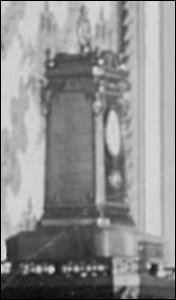
(G.) Fabergé Monumental Clock
(#486) Elizabeth Feodorovna
Vitrine in the 1902 von Dervis
Exhibition
(Stockholm’s Auktionsverk,
June 16, 2015, Lot 6524)
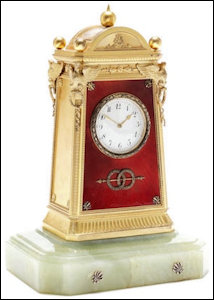
(H.) Fabergé Monumental Clock…without
Imperial markings…(#486)
(Bonhams London,
November 28, 2012, Lot 113)
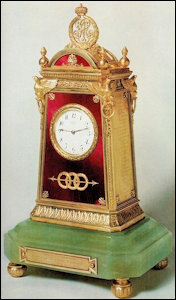
(I.) Nearly Identical Fabergé
Monumental Clock…in its
original condition
(Sotheby’s Zurich,
May 17, 1979, Lot 201)
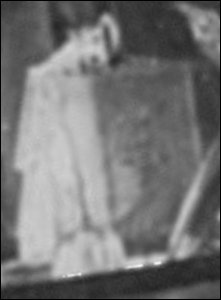
(J.) Fabergé Desk Clock (# 627) Princess
Zenaida Yusupova Vitrine in the 1902
von Dervis Exhibition
(Stockholm’s Auktionsverk,
June 16, 2015, Lot 6524)
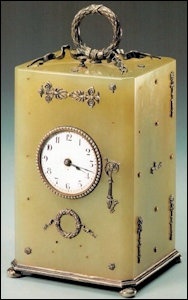
(K.) Fabergé Desk Clock…with
missing and re-arranged
ornaments…(# 627)
(“Moscow Kremlin” State
Museum Reserve of History
and Culture Exhibition,
The World of
Fabergé, 1996, p. 56, #12)
1 “Early Imperial Egg Exhibitions“, Miek’s Fabergé Eggs.
2 GARF 662-2-26.
3 GARF 640-3-20.
4 GARF 662-2-56.
5 In a paper entitled, History of the Nationalization of the Petrograd Palace of the Grand Duchess Xenia Alexandrovna, 2018. In Russian.
6 Guzanov, A. and R.R. Gafifulin, Fabergé Items of Late XIX – Early XX Century in the Collection of the State Museum of Pavlovsk, 2013, entry 2751.
7 GARF 662-2-53.
8 The Great Fabergé: The Art of the Jewellers of the Court Firm, 1990, Cover and Written Description on p. 120, Item 8.
9 “Bibliography“, Fabergé Research Site.
10 Sotheby’s London, November 27, 1961, Lot 166 sold by Leslie Berker, Chairman and Managing Director, Berkertex Ltd., Plymouth and London in OBE New Years Honors to Crawley for £360 ($1,008).
11 The two intertwined laurel wreaths and bowenite stone pattern are clearly visible on a 1902 von Dervis Exhibition photograph (State Museum Hermitage, File #410666).
12 Coutau Begarie, Paris, July 9, 2021, Lot 193.
Contact: Christel McCanless if you have more information or questions.
-
2009 “Will the Real Fabergé Stand! A Dealer’s Perspective” by Peter L. Schaffer of A La Vieille Russie, a New York City family business specializing in Fabergé and antique jewelry, shares highlights from a Fabergé lecture given to members of the American Society of Jewelry Historians.
-
2013 “Is it Really Fabergé?” by Will Lowes, senior author of Fabergé Eggs: A Retrospective Encyclopedia penned these observations after an extended study of auction catalogs. More…
-
2014 Smaller auction houses began using umbrella agencies to market their “Fabergé” objects. In 2023, these consolidators are a dominant force in marketing both types of Fabergé objects, often with generic descriptions, i.e., a Russian gilt silver enamel snuff box.2
-
2017 “Fauxbergé – Caveat Emptor!” compiled by Christel Ludewig McCanless, editor/publisher, Fabergé Research Newsletter, with research contributions from Fabergé enthusiasts worldwide.
-
2023 Hard copy Fabergé and Russian Works of Art auction catalogs are no longer printed and sold by subscription, an important part of the auction trade begun in 1934! The major auction houses no longer have specialists just for Fabergé, instead a cataloger covers several subject areas. An increasing number of Fabergé pieces appear in smaller or regional auction houses. The level of expertise for authentication of Fabergé in these auction houses is highly variable, and sometimes the auction house relies on the consignor for details. In the past, Sotheby’s and Christie’s provided a standardized nomenclature to assist buyers in understanding the described authenticity of an object. A few basic definitions from one of the last Christie’s London printed catalogs (May 3, 2021, p. 331):
“Attributed to…”: in Christie’s qualified opinion probably a work by the artist in whole or in part.
“Marked Fabergé, Workmaster…”: in Christie’s qualified opinion a work of the master’s workshop inscribed with his name or initials and his workmaster’s initials.
“By Fabergé…”: in Christie’s qualified opinion a work of the master’s workshop, but without his mark.
“In the style of…”: in Christie’s qualified opinion a work of the period of the master and closely related to his style.
“Bearing marks…”: in Christie’s qualified opinion not a work of the master’s workshop and bearing later marks.
These definitions/qualified headings can change, and vary by auction house. No written description replaces the potential owners viewing the item themselves, and ultimately practice, Caveat Emptor! The authenticity of four Fabergé or Fauxberge Fabergé objects – tea cup holder, silver rabbits, nécessaire, and glue pots/perfume bottle studied by contributors for the current newsletter issue are based on these criteria:
- Quality and style of the workmanship
- Precious metal hallmarks
- Hallmarks of the Fabergé firm and the workmasters’ marks, and
- Provenance.
Tea Cup Holder
 (A.) |  (B.) |
(A.) Fabergé Teacup Holder Intricately hand-enameled in champlevé style rather than cloisonné with dazzling pink, blue, and green enamels inside the hand wrought silver floral designs. Stamped with Fabergé factory Imperial eagle style hallmark as well as the unknown artists (F.C?). Circa 1889. 3 7/8 inches to top of handle. Russian silver standard .84 (zoltniki). Minor loss to enamel. [Ed. note: The word ‘style’ as used in this appraisal description does not in any way imply the object is not authentic.] (Gift to the Archives and Special Collections, University of Manitoba in Winnipeg, Canada) | (B.) K. Fabergé in Cyrillic Surmounted by an Imperial Eagle. Teacup Holder does not show the Imperial warrant mark the Fabergé firm was granted in 1885 for use on their objects. (Fabergé Research Website, “Workmasters and Marks”) |
Provenance: “The teacup holder was a gift to the father of the donor, alumnus Ely Bronstein (BA/70), as payment for medical treatment proffered in Shanghai, sometime in the 1930s. Dr. Gregor Bronstein and his wife Ada eventually moved out of China in 1952, and then relocated to Winnipeg in 1954.”4 Reviewing the provenance issue, suggests there is not an unbroken line from the original date when this tea glass holder was made based on the ca. 1900 hallmarks. The holder can only be traced back to the 1930’s when the donor’s father acquired it in Shanghai, China. Many Russian exiles resided in that section of China, so it is not unusual to find a Russian artifact there. (Object summary by James Hurtt, USA)
Silver Cat and Silver Rabbit
The authenticity of a silver cat and silver rabbit shown in a 2023 Antiques Roadshow (USA) is the next topic to explore. For Fabergé enthusiasts familiar with the workmanship of Fabergé, it is obvious the cat is not genuine. The fur is not finely detailed and the Antiques Roadshow (USA) appraiser pointed out the weight of the silver was nominal. One can often recognize a silver Fabergé piece because of its heft. The marks are also suspect. The rabbit’s fur appears to be more finely finished than the cat, but has atypical diamond eyes. The majority of rabbits by various Fabergé workmasters have garnet eyes serving as the push piece for elegant bell pushes and their fur coats are represented in a more realistic manner.
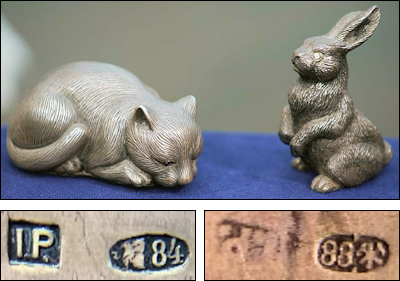 | 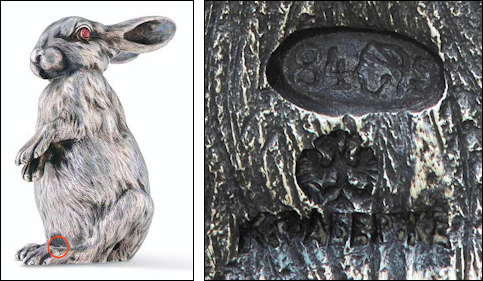 |
Silver Cat and Silver Rabbit by Julius Rappoport, ca. 1880 [Julius Alexander Rappoport, workmaster mark I.P. (Antiques Roadshow USA at Cheekwood Estate & Gardens, Nashville, Tennessee, February 13, 2023, video on PBS.org) | Gem-set silver bell push in the form of a rabbit by Fabergé, Moscow, 1899-1908, scratched stock number 12206 ... the push-piece eyes set with cabochon garnets, marked on the front edge with 'K. Fabergé' in Cyrillic beneath the Imperial warrant, price realized GBP 43,750. (Christie’s London, Live Auction, November 29, 2021, Lot 112) |
A search for silver rabbits by Christel Ludewig McCanless in auction catalogs from 1934-to the present yielded very few results – which ones are authentic Fabergé and/or match the known Fabergé authentication criteria? The rabbits in the right-hand columns of the illustrations below were made in Moscow. In the left-hand column questions remain.
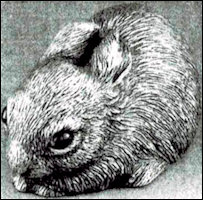 |  |
Hare, Rappoport, J.P., ca. 1910 (Ed. note: Rappoport retired ca. 1908). Silver with garnet eyes. Final bid: Austrian schilling 152,000 (Wiener Kunst Auktionen, October 2, 1997, Lot 848) | Left: Silver bellpush in the form of a bunny with gold-mounted garnet eyes. K. Fabergé, Length 4 1/4”. (A La Vieille Russie. Fabergé: A Loan Exhibition for the Benefit of the Copper-Hewitt Museum, 1983, pp. 111-112) Right:  Price realized SFr 26,450. (Christie’s, Geneva, November 16, 1994, Lot 427) The stated sizes of the two rabbits match. |
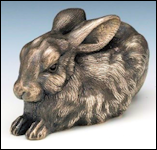 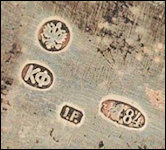 |   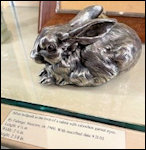 |
Fabergé Style Russian Silver and Garnet Wild Hare Cabinet Sculpture … Nicolas II style silver cabinet sculpture of a wild hare, … after Albrecht Dürer's 1502 watercolor, with round cabochon cut garnet eyes. Marked with Imperial warrant above apocryphal Cyrillic letters "KF" (for Karl Fabergé), Second Kokoshnik mark (St. Petersburg, 1908-1926) and bearing apocryphal6 maker's mark "I.P." for Julius (Yuly) Rappoport (St. Petersburg, 1883-1916) on the bottom. Provenance: Private collection, Pittsburgh, PA. Sold with Premium $1,799.50. (Aspire Auctions, Cleveland, Ohio, November 1, 2018, Lot 391) | Silver Bell Push (left and middle) in the Form of a Rabbit by Fabergé, Moscow, 1908-1917, stock number 24643. Price realized GBP 32,500. (Christie’s London, Russian Auction, November 29, 2021, Lot 117, includes a citation to the 1994 Christie’s Geneva auction) Silver Bell Push (far right) in the Form of a Rabbit with Cabochon Garnet Eyes by Fabergé, Moscow, ca. 1900 with Inscribed Date 9.II.05 $175,000 at the A La Vieille Russie Booth, 2023 Winter Antiques Show, New York City (Photograph Courtesy James Hurtt) |
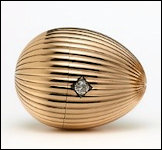 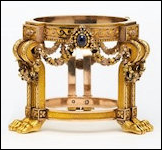 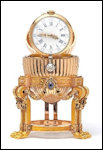 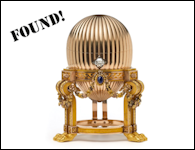 1887 Third Imperial Egg (Courtesy Wartski; Fabergé Research Site, Third Imperial Egg) and see also Third Imperial Egg (1887) in Imperial Egg Discoveries (11.08) | Summer 11 (Special Edition) | Fall 11 | Winter 11-12 | Summer 14 | Winter 14 | Summer 15 | Summer 18 |
|
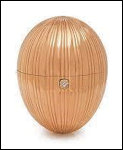   Antique Russian Nécessaire |
|
TOP: 1887 Third Imperial Easter Egg by Fabergé presented to Marie Feodorovna, a gift from Emperor Alexander III. Jewelled, ridged, yellow gold egg with original tripod pedestal, its surprise-a lady’s watch by Vacheron Constantin taken from its case to be mounted in the egg and is hinged, allowing it to stand upright. (Mieks Fabergé Eggs) History: ca. 2004. Bought for ca. $14,000 by a scrap-metal dealer in the USA. 2014. Sold by dealer to Wartski London and bought from them by an unidentified buyer for an undisclosed sum, estimated by market observers at about £20 million. (Fabergé Research Site | Wartski) | BOTTOM: Antique, Russian, yellow gold and diamond nécessaire a fluted hinged egg, the clasp containing one old mine-cut diamond measuring approximately 4.90 x 5.20 mm, the interior containing a thimble, needle threader, pencil, file, bobbin, scent flask, etui, ruler, scissors, mirror, aide mèmoire, and thread knife. Ca. 1900. Hindman Chicago, December 13, 2022, Lot 65, Estimate $8,000 - $12,000, sold for $275,000 |
Height of egg – 8.2 cm, 3 1/4 in. | 3 x 2 1/4 inches (Similar sizes) |
‘AH’ and the 56 zolotnik mark (Courtesy Kieran McCarthy, Wartski) August Holmström (1829-1903) – workmaster mark AH | Maker's mark of A.W. Holmström (sic), Fabergé workmaster's mark, Russian hallmarks. Attributed to Fabergé. (Christie’s online definition of this legal caveat - In our opinion probably a work by the artist in whole or in part.) |
-
Despite the attribution statement and based on the price realized at auction (estimate $8,000 – $12,000, sold for $275,000), there must have been several bidders, who after having examined the unusual nécessaire egg in person, agreed it was real.
-
A conundrum not resolved is the odd wording of the workmaster mark details in the Hindman auction lot description –
“Maker’s mark of A.W. Holmström (sic), Fabergé workmaster’s mark.”
Does the confusion perhaps arise from the fact that a father and son Fabergé workmaster team used the same mark during different time periods, and the identical mark and egg design features appear on the Fabergé Imperial Easter Egg given to Empress Marie Feodorovna (1847-1928) by her husband, Emperor Alexander III (1845-1894) in 1887?
Workmaster father/son team details are found in our Fabergé Research Site, Workmaster and Marks section.
August [Wilhelm, never used in marks on objects] Holmström (1829-1903) – workmaster mark AH ![]() – active 1857-1903. His workshop created the Fabergé copies of the Imperial regalia in a one- to ten-scale miniatures. The history of the tiara in the McFerrin Collection has an interesting historical connection dating back to ca. 1810 and involves the Holmström workshop ca. 1890. Two more tiaras exist with a flower theme from this same workshop, after 1903 owned by August’s son Albert. Fabergé Research Newsletter Winter 09-10 | Spring 13.
– active 1857-1903. His workshop created the Fabergé copies of the Imperial regalia in a one- to ten-scale miniatures. The history of the tiara in the McFerrin Collection has an interesting historical connection dating back to ca. 1810 and involves the Holmström workshop ca. 1890. Two more tiaras exist with a flower theme from this same workshop, after 1903 owned by August’s son Albert. Fabergé Research Newsletter Winter 09-10 | Spring 13.
Albert [Woldemar, never used in marks on objects] Holmström – Son of August Holmström, continued using his father’s mark AH ![]() – active 1903-1917. Biographical details on Albert Holmström (1876-1925). He was the son of August Holmström, who took over his father’s jewelry workshop after his death in 1903, and maintained the quality of the pieces made. It appears to be unique in the Fabergé genre that the same mark
– active 1903-1917. Biographical details on Albert Holmström (1876-1925). He was the son of August Holmström, who took over his father’s jewelry workshop after his death in 1903, and maintained the quality of the pieces made. It appears to be unique in the Fabergé genre that the same mark ![]() was used by two generations of qualified workmasters, and needs to be considered in dating a piece. Examples of their work are the 1892 Diamond Trellis Egg (2011 McFerrin Collection), and the 1896 Lilies of the Valley Basket (Matilda Geddings Gray Collection) and under Albert’s leadership, the 1913 Winter Egg (private collection) and 1914 Mosaic Egg (British Royal Collection).
was used by two generations of qualified workmasters, and needs to be considered in dating a piece. Examples of their work are the 1892 Diamond Trellis Egg (2011 McFerrin Collection), and the 1896 Lilies of the Valley Basket (Matilda Geddings Gray Collection) and under Albert’s leadership, the 1913 Winter Egg (private collection) and 1914 Mosaic Egg (British Royal Collection).
A newsletter reader with an eagle eye for details sent marks for Fabergé objects by workmaster Antti Nevalainen, active (1885-1917). The analysis below suggests there is a distinction which needs to be made in evaluating his marks.
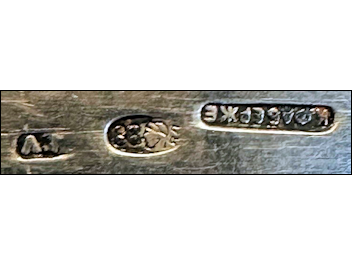
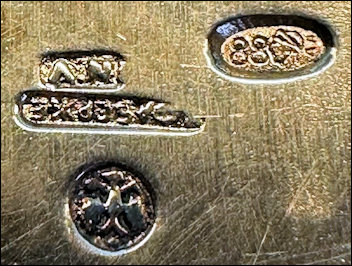
Two examples of correct AN – Antti Nevalainen hallmarks. The A appears more like an inverted “V” – ![]() than an actual A.
than an actual A.
There may or may not be a . (period) after the A or N. Many of the inaccurate or falsified hallmarks for Nevalainen incorrectly stamp an A.
(Photographs Courtesy Private Collection)
Not illustrated | 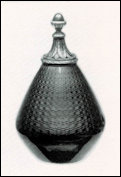 | 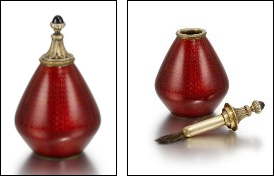 |
N/A | N/A | 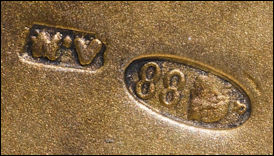 |
Fabergé silver-gilt glue pot, the pear-shaped body engine-tuned and enameled in translucent flame red, the lid chased with acanthus leaves and set with a cabochon sapphire at the top, 3 in. high, by Antti Nevalainen, fitted case. | Offered by P.H. Tytherleigh, Fabergé silver-gilt and enamel glue pot, the baluster-shaped body with strawberry red enamel over a guilloché ground, the trumpet-shaped top chased with laurel foliage surmounted with a cabochon sapphire and applied with a brush, 2 7/8 in., by Antti Nevalainen, with case. | Fabergé silver-gilt mounted and guilloché enamel gum pot, workmaster Antti Nevalainen, St. Petersburg, 1908-1917 [active 1887-1917], tapering bulbous form, enameled translucent cherry red over a wavy engine-turned ground, the brush with gadrooned cabochon sapphire-set gold finial, struck on the underside with workmaster's initials, 88 standard, height 7 cm, 2 4/5 in. |
(Sotheby’s London, November 21, 1960, Lot 84, final bid £46 to Henry) | (Sotheby’s London, May 13, 1974, Lot 181, final bid £800 to Wartski) | (Sotheby’s London, December 2, 2020, Lot 38, GBP 8,820) |
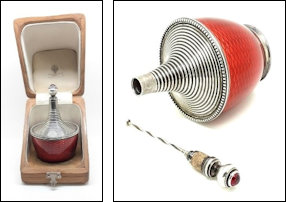 | 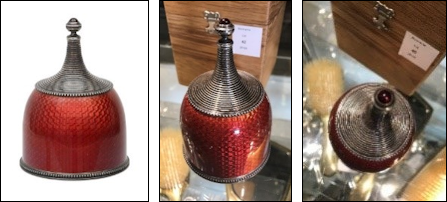 |
 | 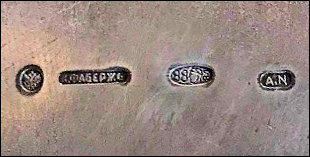 |
Russian silver and guilloche enamel perfume bottle with cabochon garnet accented stopper in fitted wood box. Stamped Fabergé (Cyrillic), AN (mark of workmaster Nevalainen, Antti 1858-1933), 88 standard mark and Imperial warrant mark. Box signed Fabergé (Cyrillic). Bottle measures 3 1/2" H, 2" W. Approx. weight: 93.2 grams. Condition: Very good (Kodner Auctions, Dania Beach, Florida [website link dated December 4, 2019], Lot 90. Estimate $3,000.00 - $4,000.00 Domestic Shipping: $34.00.) Intervendue, Miami (FL), February 28, 2020, Lot 122 (offered on the Invaluable, consolidator’s website). Est: $5,500 USD - $6,500 | Russian jeweled silver and guilloché enamel gum pot, mark of Fabergé, workmaster Antti Nevalainen, St. Petersburg, early 20th century. Tapering cylindrical form enameled in translucent cherry red over textured guilloché ground, the brush with jeweled finial, height 4 in. (10 cm). Fitted, stamped boxwood [sic] case. Auction description has “Amended” added to it. The lock on the box opens in the wrong direction. (Bonhams, Los Angeles, November 12, 2020, Lot 42, Sold for $5,355 including premium) |
1 Fabergé Research Newsletter 02.08 | Fall 08 | Fall 09 | Spring 12 | Summer 12 | Fall and Winter 17 | Spring and Summer 21
2 Aalders Auctioneers & Valuers | Invaluable
3 Rutkowski, Chris. “A Gift that Likely Won’t Be under Your Tree this Year”, UM Today News, December 6, 2022
4 Ibid.
5 Julius Alexander Rappoport (1851-1917), the leading silversmith in the St. Petersburg Fabergé ateliers, who is described as being responsible for “small objects for writing tables, to vases, to elaborate ornaments for table settings”, with the largest article known to have been produced being a surtout-de-table commissioned by Emperor Alexander III for the dowry of his daughter, Grand Duchess Xenia, in 1894 at a cost of 50,000 rubles. (Lowes and McCanless, Fabergé Eggs: A Retrospective Encyclopedia, 2001, p. 231; “Fabergé Urn at the New York Stock Exchange”, Fabergé Research Newsletter, Spring 13)
6 A story or statement of doubtful authenticity, although widely circulated as being true. (Wikipedia)
- Hard-copy auction catalogs have been replaced by online catalogs.
- Advertised ‘private sales’ supplement the traditional auction house functions.
- Acquisition of smaller auction houses [Ed. note: Cornette de Saint Cyr (France), Rasmussen, and Bukowskis (Scandinavia), Skinner (USA)] by Bonhams, London.
Sadly, more changes along with observations by newsletter readers must be added to the Adams short list. In a nutshell, newsletter contributors find it hard to do scholarly Fabergé object research (provenance and auction lot descriptions) without hard copy catalogs in their private catalog collections and/or in art libraries when neither hard copy or PDF records for auction lots are available. The auction houses, in order to save huge data storage fees and maintenance costs, have removed archival records from their online databases. Christie’s auction house begins with the year 2000, and Sotheby’s from November 2007 to the present. Do these trends give adequate protection to the buyer new to his area of interest, and/or provide researchers the needed tools to be authentic in their research efforts? How will AI (Artificial Intelligence) help in the future?
Dealer Updates from newsletter readers:
-
Andre Ruzhnikov Fine Art and Antiques (London) website illustrates over 90 Fabergé objects with archival specifics, and two auction reviews:
Sotheby’s Geneva, November 15, 2022, auction included 44 Fabergé objects annotated in “‘Scottish’ Owl Stokes Swiss Mayhem …” The analysis (November 28, 2022) concludes with a segment entitled On-line Catalogue of Errors:
“When on-line sales became predominant during Covid, auctioneers took the opportunity to post catalogues exclusively on their websites – and to forget about printed versions. It now seems Sotheby’s have stopped producing printed catalogues altogether…People love catalogues. People collect catalogues. They are both an important tool of the trade and vital for research libraries…Sotheby’s have started removing unsold lots from their catalogues posted on-line. Why? …”Another review, A Changing Market (Bargains to Be Found – If You Seek Far and Wide, December 20, 2022) enumerates in detail Fabergé lots offered by a few lesser-known auction houses in the world – Sedart (Barcelona), Millon, and De Baecque & Associés (both in Paris).
-
John Atzbach Antiques (Redmond, Washington) illustrates Fabergé objects including Feodor Rückert objects. Research Tools: “Workmaster Feodor Rückert”2 by John Atzbach, and a monograph by Tatiana Muntian3, showcase the artistic styles and techniques of the Fabergé and Rückert studios. A venue with the same title as the 2020 Muntian monograph featured 400 Rückert and Fabergé objects at the exhibition halls of the Assumption Belfry and Patriarch’s Palace in the Moscow Kremlin Museums from October 9, 2020 – January 10, 2021. The media segment on the Kremlin website mentioned above includes three fascinating videos. Of particular interest is the video entitled “Feodor Ruckert. The Art of Enamel” with English subtitles. Very educational!
Both dealers, Andre Ruzhnikov and John Atzbach, offer newsletters via free subscriptions.
-
M.S. Rau (New Orleans, Louisiana USA), a dealer in Fabergé canes, walking sticks, umbrella handles, etc., is advertising again in the Wall Street Journal, April 26, 2023, Section A10, after a long absence.
-
Fabergé objects featured by established Fabergé dealers, A La Vieille Russie, New York (NY), and Wartski, London (UK), and its participation in the Treasure House Fair, June 23-26, 2023.
-
Bonhams’ owner floats sale of auction house at $1 billion – Epiris, a private equity company which owns the auction house, has reportedly approached JP Morgan Chase & Co to advise on the deal. (The Art Newspaper, February 7, 2023)
Auction catalog research tips: Major art libraries (Watson Library at the Metropolitan Museum of Art, Frick Library, Cleveland Museum of Art, Hillwood Museum, Getty Museum, Gemological Institute of America, etc.) have long runs of hard copy auction catalogs. Researchers near their local library with interlibrary loan service may be able to obtain copies of specific catalog pages for a small fee. Scipio is a database of over 570,000 auction catalogs from the late 16th century until recently when printed auction catalogs were discontinued. Older hard copies are available for purchase from Jeffrey Eger Auction Catalogues. The website’s accompanying index stops in 2018, so direct inquiries are necessary for more recent catalogs.
Bonhams in conjunction with its recently acquired auction house, Cornette de Saint Cyr, Paris, France, sold on February 16, 2023, Lot 7: Ksenia (Xenia) Alexandrovna, Grand Duchess of Russia (6 April 1875 – 20 April 1960) PERSONAL ILLUSTRATED ALBUMS OF JEWELLERY AND BIBELOTS FROM 24th JUNE 1880 TO 1905, AND OF JEWELLERY FROM 12 JANUARY 1894 TO 25 MARCH 1912, IN TWO VOLUMES for €63,375 inc. premium. The same lot was offered by Bonhams, London, November 30, 2011, Lot 155, selling for £181,250 (€199,570). (see also Publications research ideas)
What are the actual details on a March 10, 2023, sale of an Emperor Nicholas II telephone during Romanov week? The website and the Internet appear to be silent on specifics.
A silver elephant table lighter by Fabergé (A.) with a lengthy provenance and stock number (possibly ‘13155’), a comprehensive set of photographs as well as several pages of descriptive text by Tennants (UK), and its video found a happy home with Andre Ruzhnikov Fine Art and Antiques (London). Tennants estimate £6,000 – 9,000, price realized £21,000 (March 18, 2023). A silver model of an elephant by Fabergé with wheels and a missing base (B.), Moscow pre-1898 mark sold for £4,500 including premium (Bonhams, London, March 7, 2018, Lot 135).
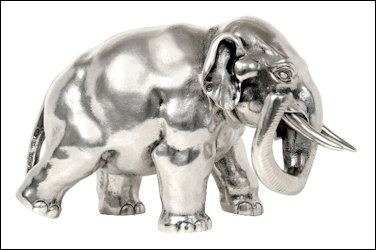
(A.) Russian Silver Table-Lighter in the Form of an Indian Elephant by
Fabergé, with Imperial Warrant, St. Petersburg, 1899-1908, Workmaster
Julius Alexander Rappoport [Fabergé workmaster], with Scratched Stock
Number (possibly ‘13155’). Estimate £6,000 – 9,000, price realized
£21,000 (Tennants (UK), March 18, 2023, Lot 2171)
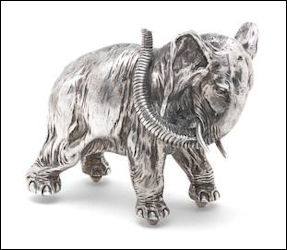
(B.) Silver Model of an Elephant by Fabergé, Moscow
pre-1898 mark modelled realistically with raised
trunk and flaring ears, the feet with screws for
a missing base. Sold for £4,500 including premium
(Bonhams London Knightsbridge, March 7, 2018, Lot 135)
- Antiques Trade Gazette, “Fabergé Elephant Table Lighter Stars in Our Pick of Six Auction Highlights”, March 31, 2023, and “Elephant with a Lighter Touch”, April 10, 2023.
Bonham’s, New York, May 23, 2023, Lot 128, Cigarette case with a provenance.
Doyle, New York, held an auction of Fabergé & Vertu, May 23, 2023.
Drouot Estimations Expertises Ventes, Paris, April 4, 2023, Lots 11-13, 17 featured four Fabergé cigarette cases.
Millon, Paris, June 9, 2023, assorted Fabergé objects.
Rasmussen, Bredgade, June 14, 2023, Objects from the Royal Private Collection of Prince Valdemar and Princess Marie of Denmark.
A reader impressed with the published auction lot detail for a monumental Fabergé kovsh (Schmidt Kunstauktionen Dresden, 07.12.2019 (December 7, 2019) complimented the auction house staff, and the Fabergé Research Newsletter authors, who are cited in the auction lot. I add my thank you to the readers and the newsletter contributors, who share their research efforts so generously:
- Sparke, C. and Hoff, DeeAnn: “Fabergé’s Monumental Kovshes with Bogatyr Themes” in: Fabergé Research Newsletter, Winter 2015.
- Hoff, DeeAnn: “From Bogatyrs to Boyars” in: Fabergé Research Newsletter, Winter 2016.
What does the future hold?
A selection of pros and cons of interesting AI (Artifical Intelligence) links shared by Rose Tozer, senior research librarian, Gemological Institute of America (GIA). She mentioned the frustrations of the GIA library staff who no longer have printed auction catalogs in their outstanding art history library in order to satisfy the needs of their students, the researchers, and the teaching staff. Students use these catalogs to learn, and be inspired by various artistic styles seen in jewelry.

(A.) ChatGPT is known to fabricate or “hallucinate” citations
(Duke University Librarians Hannah Rozear and Sarah Park, March 9, 2023)
(B.) “ChatGPT Is a Blurry JPEG of the Web OpenAI’s chatbot offers paraphrases,
whereas Google offers quotes. Which do we prefer?” By Ted Chiang, New Yorker
February 9, 2023. Article is helpful in understanding how ChatGPT works.
1 Fabergé Research Newsletter, Summer 2022
2 From a Snowflake to an Iceberg: The McFerrin Collection, 2013, pp. 274 -281.
3 Muntian, Tatiana and Marina Gor’kova, et al. Карл Фаберже и Фёдор Рюкерт. Шедевры русской эмали. (Karl Fabergé & Feodor Rückert. Masterpieces of Russian Enamel, 2020. In Russian and English.)
Cynthia Coleman Sparke published her research on an agate kovsh presented by Emperor Nicholas II on October 3, 1896, to Victor Albert Francis Spencer (1864-1934), 3rd Baron Churchill (later 1st Viscount Churchill) in “Fabergé Hardstone in Imperial Gifting from Russia to England” (e-book and hardback book entitled Courtly Gifts and Cultural Diplomacy).
The history of books and its author: Romanov Archives of Charles Sydney Gibbes is a collection of letters, journal entries, photographs and memorabilia diligently kept by the English tutor to the Russian Imperial Family and his biographical details, Charles Sydney Gibbes (1876-1963). Paul Gilbert, on his website has new, rare and second-hand books in Russian, European and British royal history, art, architecture, biographies, and more for sale before his impending retirement.
Erik Schoonhoven (The Netherlands) in “Fabergé’s Third Omen Bracelet” discusses an auction lot (Christie’s Geneva, November 10, 2015, Lot 369) presented in 1896 by Emperor Nicholas II and Empress Alexandra Feodorovna in Nizhny Novgorod. The author suggests the bracelet plays a central role in the tragedy of Nicholas’ reign. [Ed. note: Auction lot dates the bracelet to ca. 1890, Nicholas and Alexandra married in 1894, gifted in 1896, cost of 405 rubles, but unfortunately without a description or illustration of the marks.]
Kudos to the The Wall Street Journal, an American business and economic-focused international daily newspaper based in New York City with international editions published in Chinese and Japanese. The successful detective work of two reporters appeared on the front page of the Journal and in a digital format on the previous day:
-
Stu Woo and Aruna Viswanatha, “Cracking the Case: Fabergé or Fauxbergé? Justice Department in Egg Debate”, Wall Street Journal, December 8, 2022, p. A 1 & continued on p. A 14 with the title: A Fabergé Egg Debate Sizzles [Electronic version: Fabergé or Fauxbergé? The Justice Department Battles Experts Over Seized Russian Egg, Only two of the jeweled eggs made for czars are unaccounted for U.S. officials said they might have found one on a ship it seized in Fiji, Wall Street Journal, December 7, 2022]. The hard copy version states: “The whereabouts of the other two [eggs] are the obsession of Fabergé art professionals and amateur researchers. They share findings at get–togethers, which can attract 150 people, or through a thrice-a-year Fabergé Research Newsletter.” (Christel Ludewig McCanless and other Fabergé enthusiasts assisted Stu Woo, London reporter for The Wall Street Journal in his research.)
-
On February 14, 2023, a Luxurylaunches article by Neha Tandon Sharma had this headline, “When the Fabergé Is Fake, Silence Is Golden! Seven months after boasting to have recovered a multi-million-dollar Fabergé Egg from Russian oligarch Suleiman Kerimov’s $325 million Amadea Mega yacht, US officials offer nothing but silence”. The article continues – “In July 2022, U.S. Justice Department’s Task Force KleptoCapture captured headlines and an alleged bejeweled Fabergé egg worth millions …” and ends with this final paragraph: “It has been more than seven months since the US officials made a statement and followed it with no updates. A London-based Fabergé dealer found the declaration a laughing matter, ‘I just laughed,’ said Andre Ruzhnikov. ‘Justice Department clickbait,’ jibed Karen Kettering, who worked at Sotheby’s auction house. ‘It could be a chocolate egg. It could be papier-mâché. It could be ceramic,’ said Kieran McCarthy, who curated a Fabergé exhibition in London … “Sources familiar with the matter shared that after consulting experts, US officials resolved what they found was, in fact, a Fauxbergé. Silence truly is golden, even if the egg isn’t!”
David Risch, docent, Houston Museum of Natural Science (HMNS), compiled the article, “Truth is Stranger than Fiction” for the volunteer newsletter, The Dashing Diplodocus, Spring 2023, in which Rich Hutting of the HMNS staff shares his true story which happened some 10 years ago:
I showed a visitor around Fabergé when it first opened. After 15 minutes, she asked, “How do you know so much about this?” I enthusiastically raved about the Fabergé Research website administered by a person named Christel, but whose last name I couldn’t recall. “Christel McCanless?”, the visitor queried. “Yes,” I replied. The visitor smiled broadly, then said, “I’m Christel McCanless!”
A Fabergé Exhibition (Выставка Фаберже, May 15-25, 2023) shown at the Auction House “Alexander” in Moscow, includes 57 Fabergé objects with Russian descriptive texts from a private collection. The accompanying exhibition essay, “They Are Light and Good-natured …” Treasures from the Fabergé Firm (“Они легки и благодушны…”. Драгоценности фирмы К. Фаберже) by Tatiana Muntian, art critic and leading researcher at the Moscow Kremlin Museum, highlights bellpushes, boxes, frames, vanity cases, a notebook, jewelry, and silver from the Moscow branch. Our favorite historical “Fabergé” anecdote is Empress Alexandra Feodorovna’s three-button bellpush on her table – the diamond button for the nursery, the pearl button for the servants, and the ruby button for the footman. (Shared by Anna and Vincent Palmade)
II. Digital
The Afterlife of Fabergé: Fauxbergé and More, an online-lecture by Karen Kettering sponsored by the Russian History Museum in Jordanville (NY). “Over a century after the firm of Fabergé was forced to shutter the business, its name is known worldwide and continues to attract thousands of visitors to museum exhibitions, auctions, and conferences … To understand why this name remains so well-known, the author traces the efforts of dealers like Armand Hammer to promote the name of Carl Fabergé and how Hammer Galleries and others were aided by the international press and even the Soviet government …” (Ed. note: Flexible merchandising, a term coined by Kettering, and used by Hammer with his loose-leaf advertisements – without dates1 and undocumented provenances – randomly inserted into card-stock folders for ever-changing sales in department stores is an intriguing new term for Fabergé enthusiasts! It has also been called creative speculation by researchers who treasure archival provenance and comprehensive descriptive details.)
200 Years of Russian Art by Dr. Joachim Pissarro, lecture at the Russian History Museum (Jordanville, NY). Essays on Russian art tend to focus either on the 19th century and the pre-revolutionary period, or on the revolutionary Russian Avant-Garde. Very seldom does one hear about what happened artistically prior to the Revolution, during the Revolution, and – at the other end of the spectrum – at the very end (early demise) of the Soviet Union. In this lecture, the author attempts to see the multiple – and, at times, utterly contradictory – facets of what unfolded in Russia through two centuries of one of the most complex histories on this planet. (Summary courtesy of the Museum)
III. Research Challenges (Contact: Christel McCanless)
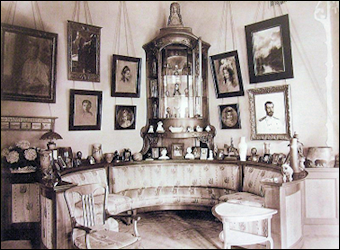
Corner Cabinet and Couch in the Maple Room
(with an interactive identification of the
Fabergé eggs shown in the center cabinet),
Alexander Palace, ca. 1914
(Alexander Lukomsky, Public domain, via Wikimedia Commons)
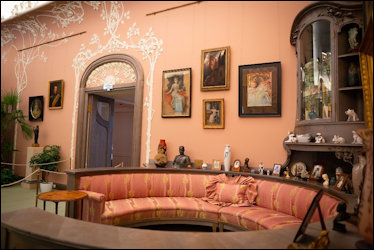
Restored Maple Room, “Alexander Palace Reopens for
First Time since 2015” in Early 2023
(Courtesy Paul Gilbert Tsar Nicholas website)
The Alexander Palace Time Machine is a comprehensive and detailed website created in 1997 as a resource for people who wanted to learn more about the palace, the Romanovs and Russian history … Bob Atchison, the owner of the website extends his invitation – “The Alexander Palace European Royalty and Russian discussion forum is going full blast and I encourage those interested in these subjects to go there and participate”. Is there a composite list of the Fabergé objects housed in the Alexander Palace during the various time periods?
Research on the German/English website, Royal Magazin, includes illustrations and details about jewelry owned by Grand Duchess Xenia. The background for this study includes archival details from two auction sales:
-
2011 Bonhams, London, November 30, 2011, Lot 155, sold for £181,250 (€199,570), including premium, and
- 2023 Bonhams in conjunction with its recently acquired auction house, Cornette de Saint Cyr, Paris, France, on February 16, 2023, Lot 7 realized €63,375, including premium.
Ksenia (Xenia) Alexandrovna, Grand Duchess of Russia (6 April 1875 – 20 April 1960). PERSONAL ILLUSTRATED INVENTORIES OF JEWELLERY AND BIBELOTS FROM 24TH JUNE 1880 [5 years of age] TO 1905 [age 25], AND OF JEWELLERY FROM 12 JANUARY 1894 [age 18] TO 25 MARCH 1912 [age 32], Sold for £181,250 (€199,570) including the premium. The albums feature almost 1,000 items and contain pictures and supporting annotations for each jewelry item she received from 1880-1912. They also serve as a kind of diary, detailing who presented the Grand Duchess with each piece, and when. Xenia’s albums record 32 years of her jewelry. The annotation published with the 2023 auction lot is quite lengthy and very informative.
An article about Xenia’s brother’s “Jewel Album of Tsar Nicholas II: Research Updated” was published in the Fabergé Research Newsletter, Fall and Winter 2019. Can the two questions asked at that time be answered now?
-
Where can readers find more information about Baroness Ekaterina Tiesenhausen, the retired lady-in-waiting to Empress Marie Feodorovna, living in the Freylinskom corridor of the Winter Palace, who preserved through her drawings the jewelry collection of Emperor Nicholas II for 24 years to be used by modern researchers?
- Who is the artist for two illustrated albums of jewelry belonging to Ksenia (Xenia) Alexandrovna at auction in 2011, and again in a 2023 sale?
A reader is interested in learning more about Fabergé object(s) in the Topkapi Palace Museum, Istanbul, Turkey, including the specifics of a Fabergé Mosque model, 19th century, donated to the museum. Are there inscriptions and/or archival records, and illustrations which may be shared in the Fabergé Research Newsletter?
Researchers Anna and Vincent Palmade in their quest to find Fabergé objects from the 1902 von Dervis exhibition from the imperial palaces and matching them to pieces extant today have a challenge. They are in need of archival photographs of the Anichkov and Gatchina Palaces. Contact: Anna Palmade
Has anyone ever attempted a compendium of Fabergé objects related to the Imperial Yacht Standart: Nicholas II’s Palace on the Seas?
Readers help needed!
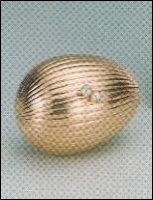
Ribbed yellow gold egg shaped
bonbonniere with pearl clasp,
1880’s. (Whereabouts of
object and earlier
citation unknown?
Contact: Christel McCanless)
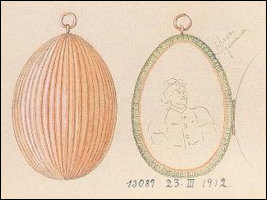
Production drawing 13089 of a miniature egg
pendant which appears to open from Henrik
Wigström’s studio dated 23.III.1912
(Tillander-Godenhielm, Ulla, et al. Golden Years
of Fabergé: Drawings and Objects from the
Wigström Workshop, 2000, p. 82).
1 A listing of the various Hammer venues known at publication time appeared in Lowes, Will, and Christel Ludewig McCanless, Fabergé Eggs: A Retrospective Encyclopedia, 2001, pp. 15-16.
